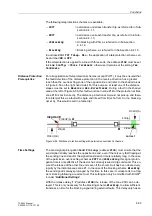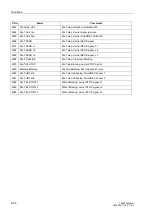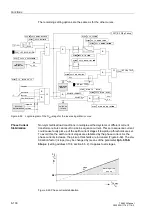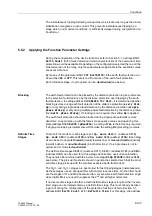
Functions
6-91
7SA522 Manual
C53000-G1176-C119-2
6.4.1.7
Measures for Weak and Zero Infeed
In cases where there is weak or no infeed present at one line end, the distance pro-
tection will not pick up. Neither a trip nor a send signal can therefore be generated
there. The permissive overreach schemes with release signals would not even be able
to trip at the strong infeed end without time delay, unless special measures are em-
ployed, as no permissive signal is received from the end with the weak infeed condi-
tion.
To achieve fast tripping at both line ends in such cases, 7SA522 provides special sup-
plements for feeders with weak infeed.
To enable the line end with the weak infeed condition to trip independently, 7SA522
has a special tripping function for weak infeed conditions. As this is a separate protec-
tion function with its own trip command, it is described in a separate section (6.7).
Echo Function
In Figure 6-55 the method of operation of the echo function is shown. It may be set
with
(Weak Infeed MODE) in address
to be on (
(&+2
RQO\
) or off (
2))
). By means of this “switch” the weak infeed tripping can also be
switched on (
(&+2DQG75,3
, refer also to Section 6.7). This setting applies to both
the distance protection and the earth fault protection teleprotection scheme.
If there is no fault detection, the echo function causes the received signal to be sent
back to the other line end as an “echo”, where it is used to initiate permissive tripping.
The detection of the weak infeed and accordingly the requirement for an echo are
combined in a central
AND
gate. The distance protection must neither be switched off
nor blocked, as it would otherwise always produce an echo due to the missing fault
detection. If however the time delayed overcurrent protection is used as an emergency
function, an echo is nevertheless possible if the distance protection is out of service,
because the fault detection of the emergency overcurrent protection replaces the dis-
tance protection fault detection. During this mode of operation, the emergency over-
current protection must naturally not also be blocked or switched off.
The essential condition for an echo is the absence of distance protection or overcur-
rent protection fault detection with the simultaneous reception of a signal from the tel-
eprotection scheme logic, as shown in the corresponding logic diagrams (Figure 6-48
or 6-50).
To avoid an incorrect echo following switching off of the line and reset of the fault de-
tection, the RS flip-flop in Figure 6-55 latches the fault detection condition until the sig-
nal receive condition resets, thereby barring the release of an echo. The echo can in
any event be blocked via the binary input „
!'LV7%ON(FKR
“.
If the conditions for an echo signal are met, a short delay
is ini-
tially activated. This delay is necessary to avoid transmission of the echo if the protec-
tion at the weak line end has a longer fault detection time during reverse faults or if it
picks up a little later due to unfavourable short-circuit current distribution. If however
the circuit breaker at the non-feeding line end is open, this delay of the echo signal is
not required. The echo delay time may then be bypassed. The circuit breaker switch-
ing state is provided by the central information control functions. (refer to Subsection
6.17.2).
Summary of Contents for siprotec 7SA522
Page 20: ...7SA522 Manual C53000 G1176 C119 2 ...
Page 64: ...7SA522 Manual C53000 G1176 C119 2 ...
Page 89: ...SIPROTEC 4 Devices 4 25 7SA522 Manual C53000 G1176 C119 2 Figure 4 20 CFC Logic example ...
Page 408: ...7SA522 Manual C53000 G1176 C119 2 ...
Page 456: ...7SA522 Manual C53000 G1176 C119 2 ...
Page 516: ...7SA522 Manual C53000 G1176 C119 2 ...
Page 620: ...Appendix B 48 ...














































